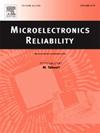Influence of top-side metal layers on the performance of gold, silver, and copper wire bonds on aluminum pads
IF 1.6
4区 工程技术
Q3 ENGINEERING, ELECTRICAL & ELECTRONIC
引用次数: 0
Abstract
This study analyzed the reliability of gold (Au), silver (Ag), and copper (Cu) wire bonds on aluminum (Al) pads coated with a multilayer Top-side metal (TSM) structure. The TSM structure was created by sequentially plating titanium (Ti), nickel–vanadium (NiV), and Ag on an Al pad, with Ag used as the surface contact layer for connection. The corrosion resistance of TSM -coated Al pads with Au, Ag, and Cu wire bonds was then examined through humidity testing, which involved pretreatment under moisture sensitivity level 3, and thermal aging at 200 °C for 5 h. The bonding interfaces of the pads were then investigated through scanning acoustic tomography, which indicated that all pads exhibited no wire bonding delamination. Testing results obtained for wire pull strength and ball shear strength indicated that the process capability index (CPK) values of the Cu wire bonds increased after thermal aging, which indicated the high thermal stability of these bonds; however, the CPK values of the Au and Ag bonds decreased marginally after thermal aging. Further analysis indicated that Au, Ag, and Cu formed solid solutions with the Ag layer of the TSM structure, and no intermetallic compound was generated; thus, the Au, Ag, and Cu wire bonds exhibited high stability and reliability even under high temperature and humidity. This study aids efforts to improve chip reliability and service life through appropriate wire material selection and TSM structure design.
求助全文
约1分钟内获得全文
求助全文
来源期刊

Microelectronics Reliability
工程技术-工程:电子与电气
CiteScore
3.30
自引率
12.50%
发文量
342
审稿时长
68 days
期刊介绍:
Microelectronics Reliability, is dedicated to disseminating the latest research results and related information on the reliability of microelectronic devices, circuits and systems, from materials, process and manufacturing, to design, testing and operation. The coverage of the journal includes the following topics: measurement, understanding and analysis; evaluation and prediction; modelling and simulation; methodologies and mitigation. Papers which combine reliability with other important areas of microelectronics engineering, such as design, fabrication, integration, testing, and field operation will also be welcome, and practical papers reporting case studies in the field and specific application domains are particularly encouraged.
Most accepted papers will be published as Research Papers, describing significant advances and completed work. Papers reviewing important developing topics of general interest may be accepted for publication as Review Papers. Urgent communications of a more preliminary nature and short reports on completed practical work of current interest may be considered for publication as Research Notes. All contributions are subject to peer review by leading experts in the field.
 求助内容:
求助内容: 应助结果提醒方式:
应助结果提醒方式:


